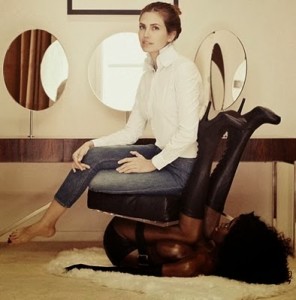
Russian Editor-in-Chief Dasha Zhukova
The latest outrage graced my Facebook feed last week. Did you see it? Russian fashion editor and debutante Dasha Zhukova posed at her desk atop a ‘chair’ made of a bound and contorted black woman. When I saw it, I did not feel outraged; rather the picture engendered a sinking feeling of ‘yup- I’m sure she did.’ This heaviness in the pit of my stomach is something that comes with seeing yet another example of accidental racism.
My disappointment over this depiction of a white woman sitting on a subjugated black woman contrasted with my appreciation of the work of Nate Hill mere days before. Hill is a black artist from Brooklyn who has begun a selfie series called Trophy Scarves (NSFW). In these photos he is dressed formally with a naked white woman around his neck. While others have called his work blatantly sexist, I found it to be an imaginative social commentary.
So why do I consider one to be great art and the other to be bigoted stupidity?
Intention.
The chair Zhukova used was an homage to the 60’s artist, Allen Jones who did several in a series where women (both black and white) were shown as tables and chairs. Though she posted the picture to her Instagram herself, Zhukova insists that “This photograph, which has been published completely out of context, is of an artwork intended specifically as a commentary on gender and racial politics.” This homage, however, was entirely lost on the viewer as Jones was never mentioned, his work being used seemingly only to portray how edgy and fashion-forward Zhukova’s magazine Garage is.
Hill’s Trophy Scarves project, on the other hand, is meant to shed light on the social phenomenon of some black men using white women as status symbols. The project’s mission statement is “I wear white women for status and power.” He is deliberately portraying these women as accessories to confront a deeply ingrained and problematic societal perception — as he said in an interview with Vice, “there are people who see certain races as status symbols, and someone had to comment”.
Therein lies the key. To be a provocateur, one must put thought into one’s actions. If an image takes an article worth of context, it is best left off of social media sites that only deal in snippets and tag lines. It is fine to outrage people, but you have to guide them into your thinking if you want anything meaningful to come of that outrage. When attempting a commentary, see your work through the lens of others and make sure your audience knows what you mean to say.




Black women as furniture; white women as scarves … can (literal) objectification ever serve a purpose? http://t.co/d8LJOArmdl @blackfems
Yes – my 2013 lesson was that CONTEXT IS EVERYTHING. But while Hill’s comment on race is fascinating, there’s a problem with gender. Because, a black man and white woman are still both marginalized people. I would’ve preferred to see him wearing a white man, or a black woman wearing a white woman.
I read this just after reading the opening arguments in the Michael Dunn “Stand your Ground” case in Florida. Both Dunn and Zhukova objectified blacks. One as furniture, the other as garbage. They both make me feel pain that so many people think this ok, that no harm is done. But the damage is substantial, and they just don’t see it. And probably never will.
The gender issue is there, granted. But his piece was to highlight that white women are less marginalized than black men and therefore can be used as a way to move up in society. Black (heterosexual) men do not use white men in this way, nor would a black (heterosexual) woman use a white woman. Were she to have the shoulders for it, though a black woman could wear a white man in the same manner.